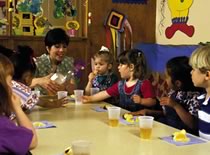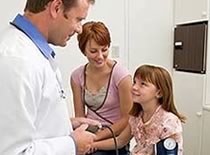H1N1 (Swine Flu): Information for Child Care Providers
May 1, 2009 8:45 PM ET
 CDC has identified an outbreak of H1N1 flu in people in the United States. An updated list of the states that have reported laboratory confirmed cases of this new flu virus in people is available at www.cdc.gov/H1N1flu. The H1N1 flu is spreading quickly from person-to-person. People have become sick with H1N1 flu in Mexico and other countries, and hospitalizations and deaths have been reported. The flu virus from Mexico and other countries is similar to the flu virus in patients who have gotten sick in the United States. CDC expects that more people will get sick from this flu in the United States. There is no vaccine for H1N1 (swine flu) virus at this time. The 2008 seasonal flu vaccine that adults and children have received is unlikely to protect against this new flu.
CDC has identified an outbreak of H1N1 flu in people in the United States. An updated list of the states that have reported laboratory confirmed cases of this new flu virus in people is available at www.cdc.gov/H1N1flu. The H1N1 flu is spreading quickly from person-to-person. People have become sick with H1N1 flu in Mexico and other countries, and hospitalizations and deaths have been reported. The flu virus from Mexico and other countries is similar to the flu virus in patients who have gotten sick in the United States. CDC expects that more people will get sick from this flu in the United States. There is no vaccine for H1N1 (swine flu) virus at this time. The 2008 seasonal flu vaccine that adults and children have received is unlikely to protect against this new flu.
Child care providers in community-based programs in all settings including both centers and home-based child care programs should:
- Create or review their plans for operations in a pandemic. This checklist can help providers to plan. Child Care and Preschool Pandemic Influenza Planning Checklist.
- Tell parents about any policies for having sick children stay at home during their illness. Children with symptoms of a flu-like illness should not come to school. Symptoms of flu include:
- Fever, cough,
- sore throat,
- body aches,
- headache, chills, fatigue,
- diarrhea in some cases.
 The child's doctor will determine whether influenza testing is needed and when the child can return to child care.
The child's doctor will determine whether influenza testing is needed and when the child can return to child care.
- In most areas, children with other mild illnesses including allergies may attend child care as long they are able to participate comfortably. Their care must not result in a need for more care than the staff can do without harming the health and safety of the other children (Caring for Our Children- Standard 3.065).
- Tell workers not to come to work if they have symptoms of the new H1N1 (swine flu). They should consult their doctor to find out if an influenza test is needed.
- Health departments in areas where people have this new flu may have stronger recommendations including child care center closing. Providers should stay informed on what is happening in their communities.
- At the current time, CDC believes that this virus has the same properties in terms of spread as seasonal flu viruses. With seasonal flu, studies have shown that people may be contagious from one day before they develop symptoms to up to 7 days after they get sick. Children, especially younger children, might potentially be contagious for longer periods.
- Establish a system to track sickness and absences with children and staff. The system should be simple and easy to keep up with. Keep a record of the number of persons with various illnesses (e.g., respiratory, diarrhea, rash) by day or at least by week. (see page 2 of Caring for Our Children Standards 3.001 and 3.002 for information on how to do this.
- These guidelines may be helpful to prevent the spread of this flu in child care facilities. “CDC Guidelines and Recommendations for Preventing the Spread of Influenza (the Flu) in Child Care Settings: Guidance for Administrators, Care Providers, and Other Staff.”
- Remind child care staff to clean/disinfect frequently touched surfaces within the facility.
- Give information to parents on actions that they can take to prevent flu. (Distribute the attached fact sheet to each parent or post on doors to the facility.
- Follow the CDC web site about this virus (www.cdc.gov/h1n1flu) and state or local health department web sites for information about possible closure or changes in operation.
- Let parents know if you suspect a child has symptoms of this new flu and consult with their doctor. Contact your child care health consultant or local public health department if you need help to make decisions quickly about health of the children as a group.
Remind children, parents and child care staff to use every day preventive actions that parents can initiate to protect their children. (Please consider posting or distributing the attached message in your child care facility).
More information on preventing the spread of the new flu can be found at: http://www.pandemicflu.gov/plan/school/preschool.html. For generic information on disaster preparedness, see NACCRRA’s web site.
More planning information for child care facilities – including state and local plans – can be found on the Department of Education's web site.
Note: This Conditions and situations are rapidly changing and these recommendations may change over time.
Preventing the Flu: Good Health Habits Can Help Stop Germs
Fact Sheet
1. Avoid close contact.
- Avoid close contact with people who are sick. When you are sick, keep your distance from others to protect them from getting sick too.
2. Stay home when you are sick.
- Stay home from work, child care, school, and errands when you are sick, except to seek medical care. Keep sick children at home except to seek medical care. You will help prevent others from catching the illness.
3. Cover your mouth and nose.
- Cover your mouth and nose with a tissue when coughing or sneezing. Cover your nose and mouth with a tissue when you cough or sneeze. Throw the tissue in the trash after you use it.
4. Wash your hands often.
- Washing your hands and the hands of your children often will help protect you from germs.
5. Avoid touching your eyes, nose or mouth.
- Germs are often spread when a person touches something that is contaminated with germs and then touches his or her eyes, nose, or mouth.
6. Practice other good health habits.
- Get plenty of sleep, be physically active, manage your stress, drink plenty of fluids, and eat nutritious food.
There is no vaccine available at this time for this new H1N1 virus, so it is important for people living in the affected areas to take steps to prevent spreading the virus to others. If people are ill, they should stay at home and limit contact with others, except to seek medical care. Healthy residents living in these areas should take the everyday preventive actions listed above.
People who live in these areas who develop an illness with fever and respiratory symptoms, such as cough and runny nose, and possibly other symptoms, such as body aches, nausea, or vomiting or diarrhea, should contact their health care provider. Their health care provider will determine whether influenza testing is needed.
- Links to non-federal organizations are provided solely as a service to our users. These links do not constitute an endorsement of these organizations or their programs by CDC or the federal government, and none should be inferred. CDC is not responsible for the content of the individual organization Web pages found at these links.
Get email updates
To receive daily email updates about this site, enter your email address:
Contact Us:
- Centers for Disease Control and Prevention
1600 Clifton Rd
Atlanta, GA 30333 - 800-CDC-INFO
(800-232-4636)
TTY: (888) 232-6348
24 Hours/Every Day - cdcinfo@cdc.gov


